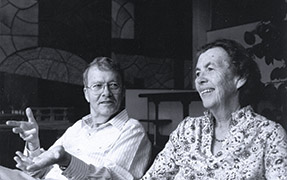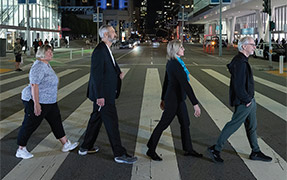Wet & Wild
Electronic imaging is in the grip of three distinct trends: decreasing image sensor sizes, increasing pixel counts, and the increasing use of image sensors for low-end applications. Smaller sensors demand smaller lens systems, whereas more pixels demand higher-quality lens systems. Downscaling conventional motorized auto-focus or zoom systems would lead to camera modules too expensive for low-end applications like camera phones. Therefore, it is not surprising that most camera phones on the market are equipped with fixed-focus lenses, which lead to out of focus pictures in most situations.
In the 17th century, Stephan Gray built several microscopes that featured a water drop as the lens. The drop was centered in a hole drilled in a plate. By using different drill diameters, he produced drop lenses of various curvatures in order to vary the magnification factor. Today, we have a much more sophisticated method to vary the curvature of a water drop that offers an avenue to very small, high-quality, low-cost auto-focus and zoom cameras.
Liquid LensWater consists of polar molecules that can be attracted by an electric field. Using an electric field, it is thus possible to change the shape of a water drop (conductor). Gorman et al. were the first to use this "electrowetting effect" to demonstrate a variable-drop lens by placing a droplet on a transparent electrode.1 The main problem with their lens was keeping it centered around the optical axis.

In our configuration, we do not have this centering problem (see figure 1).2 We coat a short glass tube with a 50-nm thin electrode, formed of indium tin oxide (ITO). The tube may also be formed of a metal, but the use of ITO allows observation from the side. An additional 3-µm-thick parylene-nitrogen layer on the inside of the ITO tube acts as an insulator between the electrode and the water. To force the water volume into a convex shape, we apply a top coat of a water-repelling fluoropolymer (AF-1600) by dipcoating. We fill the tube with an insulatora mixture of phenyl methyl siloxanes that has the same density as water in order to make the curvature of the interface between the liquids perfectly spherical and independent of orientation.
When a voltage is applied between the water and the wall electrode, the polar water molecules are attracted toward the wall. The volume of the liquids is constant, so the curvature of their interface will change. If the liquids have different refractive indices, their interface acts as a variable-focus lens.
The dioptric power of this liquid lens depends on the refractive indices of the materials and the radius of curvature of the interface. For a typical 3-mm-diameter lens, the dioptric power can be controlled between -100 and +50 diopters. This range is much wider than the range in the human eye, which can be varied between +20 and +24 diopters only. When used in a camera, the liquid lens needs only a small fraction of its range to focus from a few centimetres to infinity. For zoom cameras (two liquid lenses in series), however, the whole range can be used to obtain a large zoom factor.
Portable ApplicationsRequiring portability in an electronic imager imposes many constraints on the system. It should be compact, lightweight, and consume minimal power. It should also be shock resistant, particularly in the case of camera phones, and be able to withstand extreme temperatures.
Conventional auto-focus and zoom cameras generally perform focusing and zooming by shifting a lens with an electromotor. The motor, together with the lens-slide mechanism, makes the system bulky and vulnerable to shock, wear, or contamination with dust, sand, or rain. Moreover, a motor consumes electrical power. The liquid lens does not suffer from these disadvantages, because it changes shape instead of position and it does not require a motor. In addition, since the liquids are density matched, they are not susceptible to strong impulse forces (shocks).
The energy to drive the liquid lens is generated by charging the capacitor formed by the wall electrode and the water. Charging this approximately 100-pF capacitor requires less than a microjoule, which makes power demands for the lens extremely low. In fact, holding the lens in a certain position does not cost any power at all. Because the lens typically needs 50 V to operate, however, it does require a dc-to-dc converter to raise battery voltage. The converter does not have to generate large currents, so it can be very small and low power.
The liquid lens is shock resistant; water sticks very strongly to the bottom of the lens and does not want to be at the water-repelling wall. One challenge for the liquid lens is operating temperature range. A camera should operate between -30°C and +70°C and survive temperatures from -40°C to +85°C. In particular, the low temperatures present freezing problems for the water. We depress the freezing point of the liquid by adding large quantities of salt (e.g., lithium chloride) or antifreeze (e.g., ethylene glycol).
The operating temperature range also presents problems in the form of different thermal expansions. Usually liquids expand more than solids, causing mechanical stress in the cylinder. One solution is to add a small expansion vessel to the tube in the form of a flexible membrane or a gas bubble.
Shrinking SizesAs dimensions shrink, it becomes more difficult to assemble systems like motorized auto-focus cameras that contain moving parts. What if future image sensors go to a submillimeter scale? For the liquid lens, that is no problem at all. The cylinders can be produced in large arrays using micro-machining techniques like etching and vapor deposition. They also can be filled with liquids with microdosing techniques as used in biotechnology.
In terms of performance for miniature lenses, smaller is better. Very small lenses do not require liquids to be density-matched; thus, differences in density between liquids due to differences in thermal expansion do not affect the optical performance. Moreover, when the volume of the liquids is small, the expansion vessel can be omitted. Finally, smaller lenses are much faster: the switching time τ scales as τ ∝ d 15, where d is the diameter of the tube. For example, a typical switching time for a 3-mm-diameter lens is only 10 ms.
It is not surprising that electrowetting-based devices perform better when miniaturized. Electrowetting is essentially the control of surface tension by voltage, and surface-related forces strengthen, relatively speaking, upon miniaturization. Downscaling systems that contain moving parts introduces problems regarding friction and sticking. With electrowetting, we simply use the surface forces instead of fighting them.
The ProofWe made a demonstrator of a miniature camera using a complementary metal oxide semiconductor (CMOS) sensor (Philips OM6802) that incorporates 640 x 480 pixels with size 5.0 µm x 5.0 µm. The height of the lens stack is 5.5 mm measured from the image sensor. The lens has /2.5, a field of view of 60°, and an entrance-pupil diameter of 1.43 mm. We position the electrowetting cell between two plastic injection-molded lenses (see figure 2).

A flat glass plate closes the cylinder on the oil side, whereas a truncated glass sphere mounted on a thin metal diaphragm closes the side of the salt solution. The outer diameter of the cylinder is 4 mm, the inner diameter 3 mm, and the height is 2.2 mm. The flexible metal diaphragm provides expansion capability to partially compensate for thermal expansion mismatch between the liquids and the cylinder.
The achromatized lens stack has a high optical quality: the camera resolution is limited by the pixel size, rather than by the lens stack. A pair of consecutive frames captured by our camera, which was focused on 50 cm and 2 cm, respectively, shows good focusing. The focus time was faster than the time interval of 40 ms between the two frames.
Miniature portable-electronic-imaging devices like camera phones set a lot of requirements for auto-focus or zoom systems that cannot be met by simply downscaling conventional motorized systems. We have shown that variable-focus liquid lenses have properties that make them ideal to fill this gap. They are fast, compact, low power, robust, and have the potential to become a low-cost mass-produced product. oe
Kuiper an Inventor From Day One
Stein Kuiper couldn't tie his shoes. His mother tried to teach her two-year-old, but it just seemed too difficult for him. Then, on his third birthday, Kuiper had a dream in which he came up with a new shoe-tying strategy. "It was my first invention and I used the method for many years," he says. "When I was three years old, my mother told everyone that I would become an inventor, and that is the only profession that I ever wanted," says Kuiper, who is now a senior research scientist at Philips Research (Eindhoven, the Netherlands).
Kuiper studied physics at Eindhoven University of Technology, and while in school, worked at Shell Solar (Amsterdam, the Netherlands) on a project to improve the efficiency of solar cells. He was a student athlete in track and field, and eventually became Dutch champion in the discus throw. After graduation in 1993, Kuiper concentrated on athletics for a year, but serious injuries led him back to a career in the sciences.
In 1996, Kuiper started his doctorate work at Twente University of Technology (Enschede, the Netherlands), where he studied silicon microsieves-filtration membranes with micron-sized pores. After he completed his thesis in 2000, he started work at Philips, concentrating on electrowettingchanging the shape of a water droplet with an electrical field. Kuiper started developing a variable liquid lens on his own, and principal research scientist Benno Hendriks joined him later to work on further development.
Kuiper's son, Thomas, was born on Kuiper's birthday, the "magic birth date of 03-03-03." "He is not three years old yet, but he is so extremely curious that I am already convinced he will become an inventor," Kuiper says. No word yet on whether the kid can tie his shoes. Neil Savage
References
- B. Gorman, H. Biebuyck, and G. Whitesides, Langmuir 11, p. 2242 (1995).
- S. Kuiper and B. Hendriks, Applied Physics Letters 85, p. 1128 (2004).



